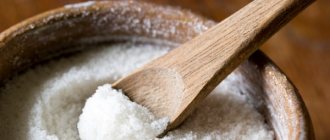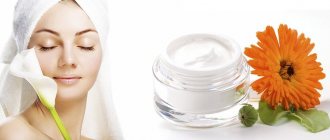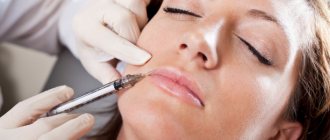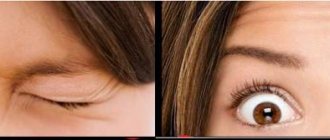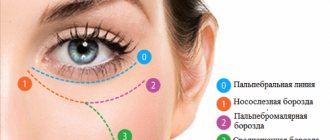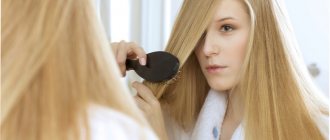What is this?
Natrii hyaluronas, Sodium hyaluronate (sodium hyaluronate) is a polysaccharide consisting of disaccharide repeating chains. The latter will be connected to each other by glycosidic bridges. Another name is sodium salt of hyaluronic acids. It is a derivative of non-sulfonated glucosamine, which is part of epithelial, connective and nervous matter, and is the main element of the cell matrix.
Sodium hyaluronate belongs to several pharmacological groups:
- Diagnostic drugs.
- Metabolics, as well as correctors of metabolism (metabolism) in bone and joint tissues.
- Reparants and regenerates.
- Organotropic category products.
- Ophthalmic drugs.
Based on all of the above, the pharmacological action of sodium hyaluronate will be as follows:
- Analgesic (in other words, pain reliever).
- Diagnostic.
- Anti-inflammatory.
- Keratoprotective.
- Corrective metabolism in joint and bone tissues.
Hyaluronic acid: description
Hyaluronic acid is one of the skin's most natural moisturizers.
Sodium hyaluronate is a polysaccharide that is present in the human body, namely in its tissues and cartilage. The substance looks like a white powder. It is poorly soluble in water. If there is a lack of this component in the tissues, the skin becomes dry, its elasticity decreases, and early wrinkles appear. Therefore, modern cosmetology widely uses various cosmetics containing hyaluronic acid.
The following types of this substance are distinguished:
- Low molecular weight sodium hyaluronate;
- High molecular weight hyaluronic acid.
Low molecular weight hyaluronic acid
Low molecular weight sodium hyaluronate is small in size and has the ability to easily penetrate tissue, due to which it has a maximum effect from the inside on each cell.
This type of sodium hyaluronate has the following effect:
- Moisturizing effect;
- Stimulating effect;
- Fighting wrinkles;
- Activation of fibroblast activity;
- Accelerates the penetration of nutrients under the skin.
High molecular weight hyaluronic acid
High molecular weight hyaluronic acid is larger in size and is used in cosmetology practice only as a means for external use. The following main properties can be distinguished:
- Moisturizing the stratum corneum;
- Regeneration;
- Antioxidant effect;
- Anti-inflammatory effect;
- Lifting effect.
Pharmacological properties
What can be said here about sodium hyaluronate preparations? Their active substance, Sodium hyaluronate, is a natural element that is present in connective tissues, the intercellular matrix in many animals, as well as in humans. This substance is designed to improve the viscosity and elasticity of tissues.
Sodium hyaluronate solutions are widely used in ophthalmic activities:
- The drug facilitates the separation of eye tissues.
- Expands the anterior ocular chamber.
- Responsible for ensuring transparency of visual fields.
- Reduces the likelihood of traumatic damage during surgery, examination of the retinal tissues of the eye, including the endothelium of the cornea.
The element is also used as a substitute for synovial fluid. At the same time, it is able to improve its rheological qualities. Helps normalize processes during arthrocentesis. For osteoarthritis, sodium hyaluronate will reduce pain and improve the physical functions of joints.
Trade names
Let us note one fact. Sodium hyaluronate is not a stand-alone medicine. This is the name of the drugs that have the active ingredient Sodium hyaluronate. Their trade names will be completely different - according to the instructions of the manufacturing company.
Let's present the most well-known products on the world and domestic market containing sodium hyaluronate:
- "Healon."
- "Aistil."
- "Hilo Chest of Drawers."
- "Intragel".
- "Fermatron".
- "Healon."
- "Sinoart".
- "Giaferon".
- "Adant."
- "Synovial".
- "Regitsin".
- "Hilozar-Chest of drawers".
- "Gialgan Phidias" and so on.
Sodium hyaluronate price
When citing the price of a drug as an example, one should rely on the cost of products with different trade names. The active component in them will be sodium hyaluronate. These are “Aistil”, and “Adant”, and “Khialon”.
What is the average price for sodium hyaluronate for joints? One ampoule will cost you approximately 4000-5000 thousand rubles.
For example, the drug “Gialgan” is sold in pharmacies at an average price of 4.5 thousand rubles per ampoule (2 ml - 20 mg). And the Adanta solution of the same packaging will cost about 5 thousand rubles.
Cosmetics with hyaluronic acid
Doppelhertz
Vitamin complexes containing sodium hyaluronate are available in the form of capsules or tablets and create a lifting effect.
The Doppelhertz lifting complex has high properties, which contains, in addition to acid, beta-carotene, vitamins, selenium and zinc. Doppelhertz improves complexion, protects the skin from the effects of the external environment and has an antioxidant effect. For adults, it is recommended to take one capsule of the drug with meals. The general course of treatment is one month, followed by a month break.
Juvederm
Among all fillers, Juvederm is considered the most popular, since it contains hyaluronic acid of non-animal origin. This helps reduce the risk of an allergic reaction or side effect several times. The substance can be injected into the superficial, middle or deep layers of the skin.
Each Juvederm product contains lidocaine, so there is no need for painkillers during the procedure.
Injections are used to smooth out nasolabial folds, smooth out facial contours, enlarge lips and fill wrinkles. The effect lasts for 5-8 months, depending on the area of injection.
Libriderm
Popular cosmetics with sodium hyaluronate include Libriderm cream, which has a light texture and a high acid content.
It can be applied to the décolleté, face and neck as it intensely moisturizes and nourishes the skin and helps fight the signs of aging. After regular use of the cream, the microrelief improves, a natural glow appears, the complexion improves and the skin becomes smoother. Tip: Choosing a product or procedure using hyaluronic acid depends on the individual problem and the desired result. You can get the maximum effect only by administering subcutaneous injections.
Sodium hyaluronate mask
In order not to spend a lot of money on trips to expensive beauty salons or on preparations with hyaluronic acid, you can prepare a healthy mask or cream yourself at home. It should be remembered that it will not be possible to achieve the same effect as during injections, because such products can only act on the surface layer of the skin.
A mask with hyaluronic acid will help eliminate fine wrinkles, change your complexion for the better and provide the skin with good hydration.
To prepare it you will need the acid itself or a salt of the acid with sodium. You can buy these components in city pharmacies or order through an online store.
Sequencing:
- It is necessary to measure 2 g of hyaluronic acid powder and dilute with 30 ml of boiled warm water;
- All components should be thoroughly mixed and left until completely swollen for one hour;
- If lumps appear, you need to knead them thoroughly and then apply the finished mask to a face cleansed of cosmetics;
- The mask is applied in a thin, even layer over all surfaces of the skin and remains until completely absorbed. No need to rinse off.
To obtain maximum results, about 11 procedures are necessary.
Advice: Before using hyaluronic acid, it is advisable to see a doctor in order to exclude the presence of direct contraindications.
Indications for use
Indications for the use of sodium hyaluronate preparations (solutions, powder) are wide.
Associated with diseases, pathologies of joints, bone, cartilage tissue:
- Osteoarthritis.
- The need to introduce the drug into the joint cavity.
- Replenishment of synovial fluid volume.
- Improving joint mobility.
- Relief of pain in joint diseases.
- Osteoarthritis.
- Pathological changes in joint tissue.
- An auxiliary agent used in orthopedic surgery.
Indications in the field of ophthalmology:
- Operations on the posterior and anterior ocular segments.
- Facilitation of intra- and postoperative examination of the retina.
- An auxiliary agent for laser surgery.
Types of connection
Sodium hyaluronate is usually divided into two types:
- low molecular weight;
- high molecular weight.
The high-molecular type is used for cosmetic purposes, because the substances contained in it act more on the surface of the skin without penetrating deep into the tissues. This substance promotes
- moisturizing the skin;
- makes facial skin elastic and toned;
- eliminates folds and wrinkles;
- provides better thermoregulation.
In other words, the high-molecular type of substance has a greater effect on the external signs of the skin, which, of course, cosmetologists know about and actively use it in various cosmetic preparations.
The low-molecular type is capable, on the contrary, of penetrating deep into the tissues and cells of the body. This is its main difference. It is capable of establishing protective barriers, capable of protecting the skin from exposure to ultraviolet and direct sunlight, as well as other mechanical influences. The main function of low molecular weight hyaluronate is a protective function.
Restrictions on the use of the drug
Solutions, powders, drops of sodium hyaluronate are not recommended for use in the following categories of patients:
- Pregnant women.
- Mothers during lactation.
- Children.
The limitation is due to the fact that there is no clinical data on the safety of the drug in these categories of people.
Doctors also advise elderly people to use the product with caution. Individual dosage adjustments may be required.
Contraindications for use
Despite the obvious advantages, not everyone can use cosmetics or preparations with hyaluronic acid. In some people, sodium hyaluronate can cause a number of side effects such as redness or itching of the skin and bruising. Therefore, the following contraindications exist:
- Pregnancy;
- Breastfeeding period;
- The presence of open wounds or other damage to the skin;
- Allergy;
- Individual intolerance to components;
- Inflammatory processes on the skin;
- Infections;
- Poor blood clotting.
Sodium hyaluronate will help preserve the youth and beauty of the skin for a long time; you just need to choose the rejuvenation option that suits you. It is recommended to first visit a doctor and find out if there are any contraindications in order to avoid unwanted side effects.
Features of using the product
Sodium hyaluronate is introduced into the human body in two ways:
- Intraocular - in ophthalmology.
- Into the joint cavity - in the treatment of diseases of bone and cartilage tissue.
The frequency of administration and dose volume are individual values that are prescribed by the treating specialist.
If we talk about the effectiveness of using sodium hyaluronate for joints, most patients note that local reactions cease to be felt after a few days. If they remain pronounced or hyperthermia develops, then the administration of the drug is stopped.
Now the field of ophthalmology. Here, monitoring the level of intraocular pressure is recommended. Especially in the postoperative period when the sodium hyaluronate solution must be left in the eyeball. If there is no need, then the product is completely removed from the eyeball.
When using (especially repeated), all risks associated with the introduction of biological material should be taken into account. It is recommended to pre-cool/warm the solution to a comfortable room temperature.
Dosage, frequency of administration
We indicate the average values.
The maximum amount of product that can be used in ophthalmology:
- Injection into the anterior ocular chamber - 1 ml of the drug.
- Injection into the posterior ocular chamber - 2-4 ml of the drug.
As for intra-articular administration, one injection per week is acceptable. The entire course of treatment, on average, is limited to 5 such injections. The injection locations are as follows:
- Subacromial bursa.
- Cavity of the knee joint.
- Shoulder joint cavity.
- Tendon sheath.
- Other synovial joints.
The dosage is prescribed by the treating specialist. It is directly influenced by the severity of the disease and the patient’s condition.
Hyaluronic acid
The presence of hyaluronic acid in cosmetics can be determined by the inscriptions Sodium Hyaluronate, Hyaluronic Acid . In cosmetics, the content of hyaluronic acid usually ranges from 0.2 in creams to 2% in serums.
Effect of cosmetics with hyaluronic acid 69839
Properties of hyaluronic acid used in cosmetology:
Rejuvenating . Hyaluronic acid in cosmetics is able to penetrate and remain deep in the skin, stimulating the synthesis of collagen and elastin fibers, toning and refreshing the skin.
Moisturizing . One molecule of hyaluronic acid is able to attach about a thousand water molecules, retaining moisture in the layers of the skin, and also transport vitamins, minerals and nutrients into the deeper layers.
Smoothing. Hyaluronic acid fills the depressions in the skin formed by wrinkles, helps to even out and smooth the skin texture.
Anti-inflammatory . Hyaluronic acid molecules have anti-inflammatory and mild analgesic properties, blocking the activity of pathogenic bacteria, so creams and serums with hyaluronic acid are often prescribed for skin care after plastic surgery or deep peelings.
In medicine, preparations with hyaluronic acid are actively used in ophthalmology, for the treatment of joints with arthritis.
When using cosmetics with hyaluronic acid - in case of a tendency to allergies.
Cosmetics with hyaluronic acid are stored in the refrigerator in tightly closed bottles.
What cosmetics contain hyaluronic acid?
- moisturizing emulsion, cream, serum
- cosmetic compositions for mesotherapy, biorevitalization
- fillers
- cream, mask, serum for aging skin
- lipstick, lip gloss
Hyaluronic acid in cosmetics (Hyaluronic Acid) 59783
The use of hyaluronic acid is undesirable:
When carrying out biorevitalization or contouring procedures using hyaluronic acid - in the presence of any infectious, allergic, autoimmune, atopic dermatitis.
Are cosmetics with hyaluronic acid harmful?
The composition of creams, serums and gels includes chemically treated and modified hyaluronic acid, so creams with it are hypoallergenic.
What is hyaluronic acid used in cosmetology?
Hyaluronic acid is an organic substance from the class of polysaccharides. Hyaluronic acid is also found in our body.
Hyaluronic acid became known to us thanks to scientists Carl Meyer and John Palmer, who in 1934 first isolated this substance from the vitreous body of the bull's eye, and called it a combination of the words hyalos - from the Greek “vitreous” and uronic acid (a polymer, a component of hyaluronic acid). acids).
The defining property of hyaluronic acid, thanks to which it has gained unfading fame, is its ability to bind and retain water. One molecule of hyaluronic acid is capable of retaining moisture a thousand times its volume.
As soon as the role of hyaluronic acid in maintaining skin smoothness and elasticity became known, cosmetologists around the world began to search for ways to preserve hyaluronic acid in skin tissue and ways to replenish its reserves.
The hyaluronic acid molecule is quite large, significantly larger in volume than the size of the skin pore, therefore, when a cream with hyaluronic acid is applied to the skin, the substance is distributed over the surface with a thin moisturizing film, giving smoothness and elasticity only to the surface of the skin, but without penetrating deep into it. Modern scientists are working to find ways to break up hyaluronic acid macromolecules into smaller particles.
Japanese scientists recently published a report that they managed to achieve a particle size of hyaluronic acid of 3 nm (five times smaller than the width of a skin pore), and now hyaluronic acid is able to penetrate into the deep layers of the skin, carrying with it not only moisture, but also other beneficial properties. skin substances (for example, silver particles, vitamins).
Where do you get hyaluronic acid for cosmetics?
Initially, the source of hyaluronic acid was animal tissue. However, such hyaluronic acid often caused allergies and required a very high degree of purification from animal protein.
Currently, cosmetic and pharmaceutical companies synthesize hypoallergenic hyaluronic acid biotechnologically.
Effective hyaluron (for lips - at least 20, for the oval of the face and nasolabial lips from 35+)
Most often, the supply of hyaluronic acid to the skin tissue is ensured through salon procedures, where a liquid and dense consistency of this substance is used. Liquid hyaluronic acid is used for the biorevitalization procedure, during which it is injected deep into the skin using injections, oxygen or laser. Gel-like hyaluronic acid is used for contouring (fillers), when wrinkles are filled with this substance and the oval of the face is formed.
Hyaluronic acid injections are still more effective than hyaluronic serums 58616
Getting rid of wrinkles with hyaluronic acid injections: quick results
Do you want quick results? - Please! Inject drugs with hyaluronic acid (fillers). You will see an immediate transformation, as the drug, injected under the skin, fills the nasolabial and glabellar folds, smoothing the skin for 6-10 months.
Biorevitalization with hyaluronic acid injections
The combination of hyaluronic acid with biorevitalization provides a lasting effect of moisturizing and smoothing wrinkles (about 6 months, at 35 years old).
We correct lips with injections with hyaluronic acid
Most often, lips are corrected with hyaluronic acid. Age does not play a role in this case, because the shape of the lips can cause distress due to congenital narrowness or due to postoperative asymmetries.
Application: 1 time every 6-8 months.
Injections with hyaluronic acid enlarge lips and correct their shape 58530
Injection correction of the volume and contour of the lips is carried out by subcutaneous injection of a drug based on hyaluronic acid, which is selected individually by a cosmetologist to eliminate allergic reactions. Getting under the skin of the lips, hyaluronic acid strengthens the intercellular matrix and converts the water molecules bound by it into a viscous gel, making the lips look juicy, round and keep their shape perfectly.
If during the first session it was not possible to achieve the desired volume or correct the asymmetry, then after 2-4 weeks you can additionally inject a portion of the drug with hyaluronic acid.
Effect: After injections with hyaluronic acid, lips “keep” their shape and volume for 6-8 months. Many patients of cosmetic clinics claim that after injection lip correction with hyaluronic acid, they began a new life - full of smiles and joy from the admiring glances of others.
Cosmetics with hyaluronic acid:
- Anti-wrinkle cream with hyaluronic acid Vichy LiftActiv Derm Source dry skin
Problem solving: dry skin, wrinkles (30 years +)
Application: once a day, daily.
Effect: smoothing of wrinkles by 20% after 7-8 weeks of use.
- Intensive moisturizer for dry skin with hyaluronic acid La Roche-Posay Hydraphase UV Riche Targeted Rehydration
Problem solving: dry skin, wrinkles (30 years +)
Application: morning and evening
Effect: instant hydration and softening of the skin, and even if you stop moisturizing the skin with hyaluronic acid cream after 6 weeks of regular use, the effect will last for another month. Protects skin from the damaging effects of ultraviolet radiation.
- Regenerating night cream against wrinkles with hyaluronic acid Clarins Extra-Firming Night Cream
Problem solving: wrinkles, dull complexion (available for dry and normal skin) (40 years +)
Application: daily for 1-2 months.
Effect: by morning, the skin is significantly smoother, fresher, without cream the effect lasts 3-4 weeks.
By-effect
Divided into two categories.
Side effects when injected into the joint cavity:
- Feeling of warmth, heat.
- Painful effect.
- Swelling formation.
- Redness.
- A fairly rare manifestation is an increase in body temperature or more pronounced locational (local) reactions.
Side effects when using the solution in ophthalmology:
- A temporary increase in intraocular pressure, which is observed during the postoperative period. Appears 4-8 hours after surgery.
- It is necessary to completely remove sodium hyaluronate from the eyeball. Otherwise, the drug causes a mechanical blockade of the trabecular meshwork. And this already causes increased eye pressure.
Interaction of the drug with other drugs
It is important to highlight the following points here:
- Sodium hyaluronate, according to clinical trials, is incompatible with cationic solutions.
- The drug is not prescribed for complex administration as part of other intra-articular injections. The limitation is due to the fact that so far in medicine there is no significant and evidence-based experience of the safety of such use of the drug.
- It is not recommended to use disinfectants that contain quaternary ammonium salts together with sodium hyaluronate. What is this connected with? In the presence of these substances, hyaluronic acid begins to precipitate.
Hyaluronic acid in cosmetics
Many people have heard about hyaluronic acid, but not everyone knows what it is needed for. This substance has a number of beneficial properties for our skin. In cosmetics, it acts as a moisture-retaining agent and stimulator of collagen production.
Properties
The main beneficial property is skin hydration. Hyaluronic acid binds and holds water molecules, making the upper layer of the epidermis more elastic. It stimulates collagen production, helping to maintain youthful skin and elasticity. The substance also relieves inflammation and has a healing effect. Hyaluronic acid enhances the effect of other moisturizing and nourishing components, significantly increasing the efficiency of care products.
Where is it found?
The component is found in most moisturizers intended for dehydrated skin. It is present in high concentrations in serums and special moisturizing gels. For example, hyaluronic gel “Aloe vera” and “Squalane” . In these products, the effect of the main component is enhanced by natural moisture-retaining components. Aloe is known for its healing properties, and squalane is a skin-related ingredient. It quickly penetrates into the deep layers, providing a pronounced protective effect. These products are applied underneath the cream to moisturize the skin and prepare it for the cream.
Serums are the most concentrated products that belong to the “heavy artillery”. They are applied under cream or on their own, for example, in the summer. Hyaluronic acid is found in the Moisturizing facial serum , where it works in combination with other ingredients. This is a potent remedy intended for course use.
But not just serums and gels - it is added to cleansers and intermediate products. For example, the new “Anti-Aging” foam-mousse wash with hyaluronic acid gently cleanses and does not dry out the skin. After it comes the “Rejuvenating” tonic for the face and area around the eyes . Perfectly moisturizes, leaving the skin fresh as a rose petal.
Another area of application is body creams. In our assortment you can find “Moisturizing” emulsion . This is a light, quickly absorbing cream, more like milk. Hyaluronic acid will help moisturize and smooth the skin, and the remaining components will complement its beneficial effect.
The content of hyaluronic acid helps maintain an adequate level of hydration, relieve irritation and redness. Synergy with natural active ingredients allows you to achieve excellent results!
Have you already used our products with hyaluronic acid?
